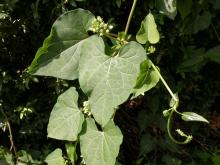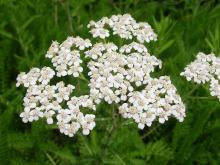Wildflowers, Grasses and Other Nonwoody Plants
Media

Species Types
Scientific Name
Euphorbia esula
Description
When you consider the negative effects this plant has on natural habitats, and how hard it is to control or eradicate, you almost want to rename it “leafy scourge”! This invasive plant is spreading in our state. Learn how to identify it.
Media

Species Types
Scientific Name
Phytolacca americana
Description
A tall, smooth, branching plant with red stems and juicy, dark purple berries, pokeweed is both toxic and a traditional edible potherb called poke salat. It is common statewide.
Media

Species Types
Scientific Name
Datura stramonium
Description
Pretty but poisonous, jimsonweed has white goblet-shaped flowers that open around midnight. This native of tropical America was introduced nearly throughout the United States and thrives in disturbed soils.
Media

Species Types
Scientific Name
Daucus carota
Description
Queen Anne’s lace is many things to many people — roadside wildflower, noxious introduced weed, wild edible, medicinal herb, delightful cut flower. In Missouri, it blooms May through October.
Media

Species Types
Scientific Name
Persicaria amphibia (formerly Polygonum amphibium)
Description
Water smartweed can live submerged in water, or on wet banks or other soggy ground, yet it can also live in merely moist areas. The stems often sprawl as they grow, taking root at the swollen nodes. The small, pink flowers develop in long, erect clusters.
Media

Species Types
Scientific Name
Cynanchum laeve
Description
Bees, butterflies, and other insects love its nectar, but sand vine is also a problem weed that can be difficult to eradicate. Some people cultivate it as an ornamental. Beekeepers value it as an excellent honey plant.
Media

Species Types
Scientific Name
Achillea millefolium
Description
Native to North America, Europe, and Asia, yarrow has been used for medicine and magic for millennia. This aromatic plant has fine, hairy, fernlike leaves and flat-topped clusters of little white flowers.
Media

Species Types
Scientific Name
Euphorbia corollata
Description
With widespread sprays of small white flowers, flowering spurge looks a lot like the "baby's breath" so popular with florists. Each little "flower" has 5 white false petals surrounding a cup of tiny yellow male flowers and a single female flower.
See Also
About Wildflowers, Grasses and Other Nonwoody Plants in Missouri
A very simple way of thinking about the green world is to divide the vascular plants into two groups: woody and nonwoody (or herbaceous). But this is an artificial division; many plant families include some species that are woody and some that are not. The diversity of nonwoody vascular plants is staggering! Think of all the ferns, grasses, sedges, lilies, peas, sunflowers, nightshades, milkweeds, mustards, mints, and mallows — weeds and wildflowers — and many more!





















